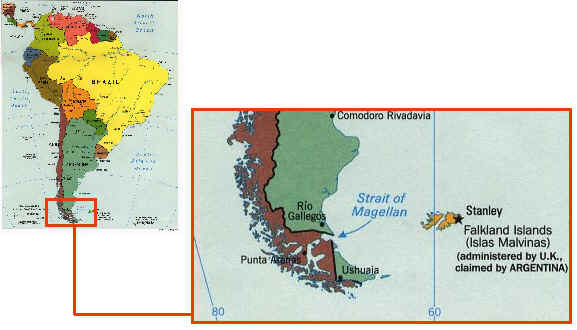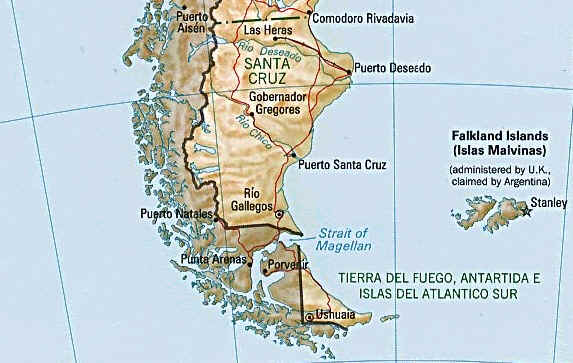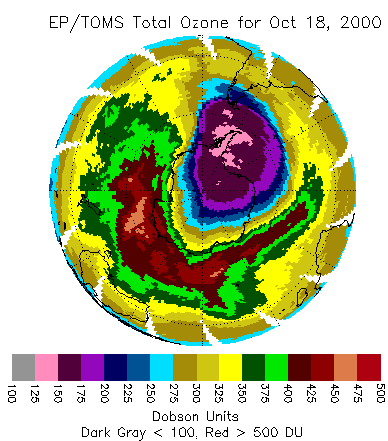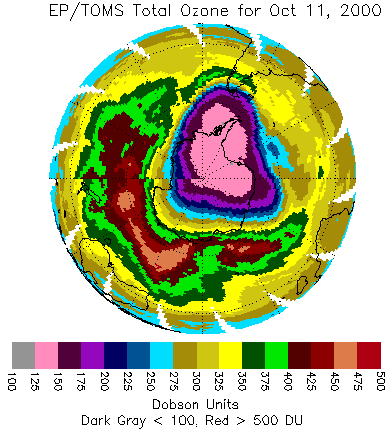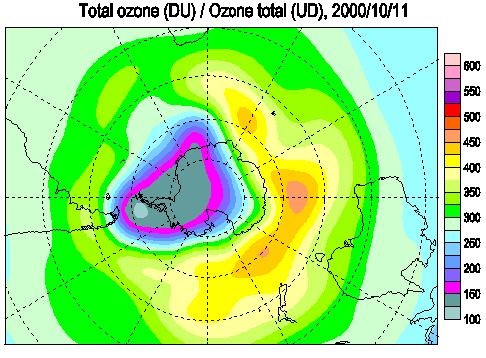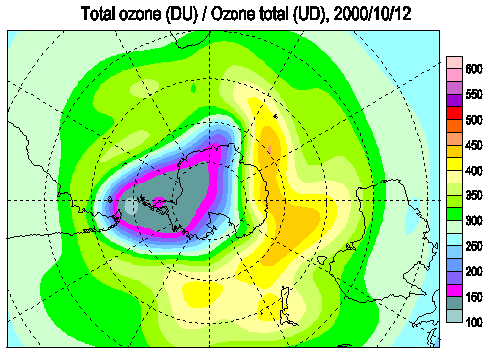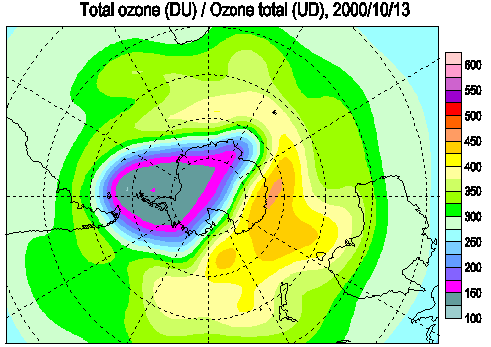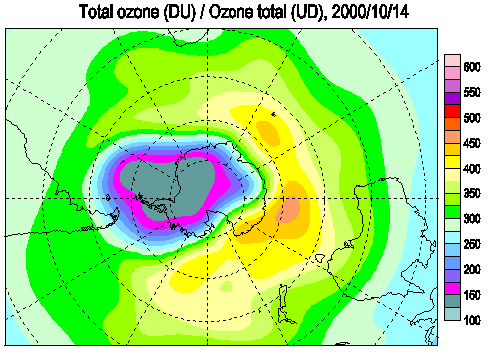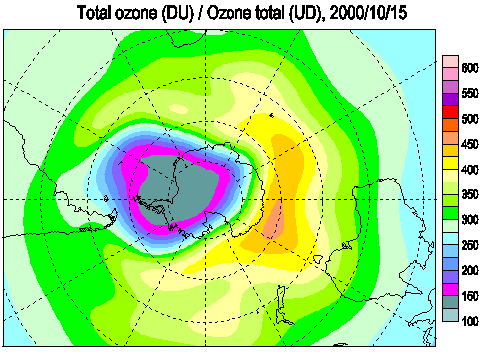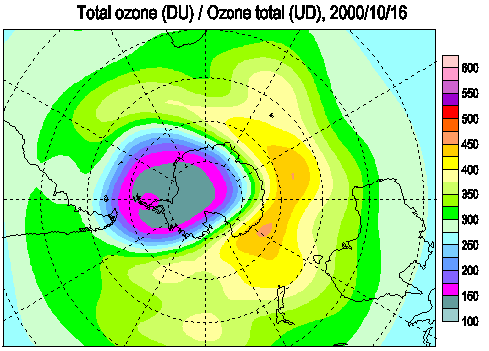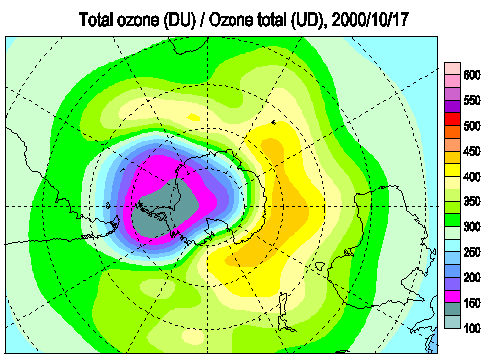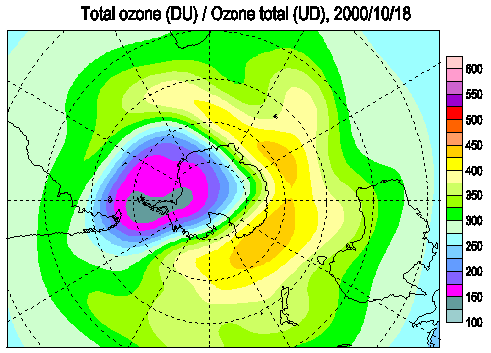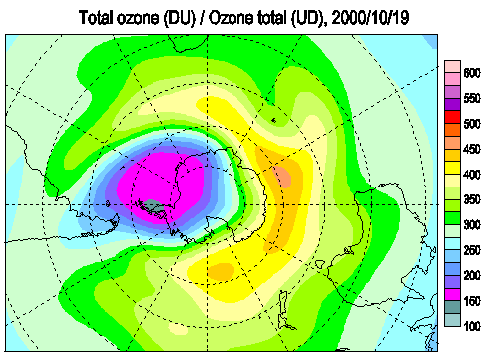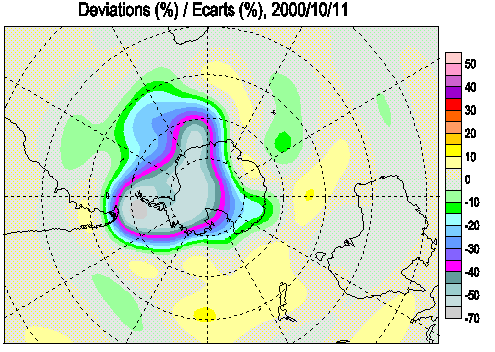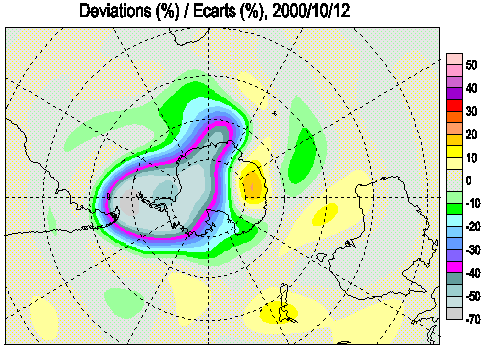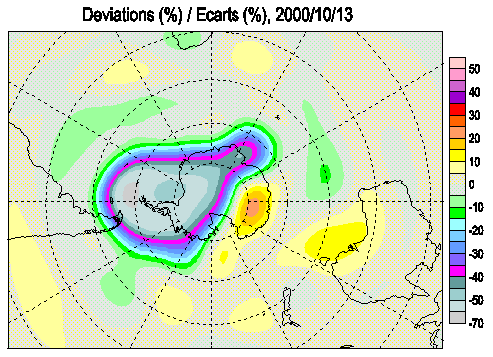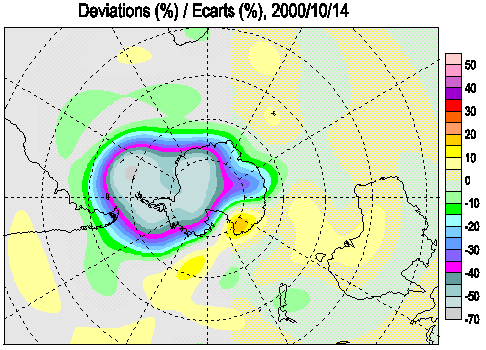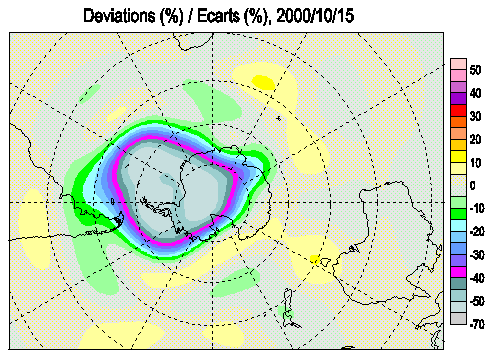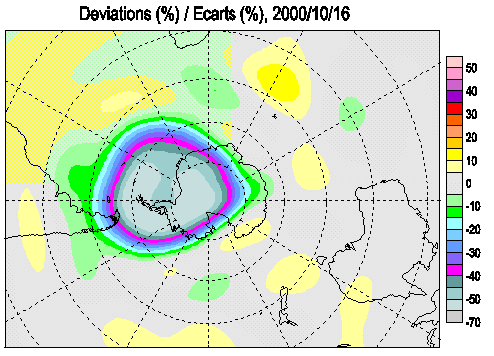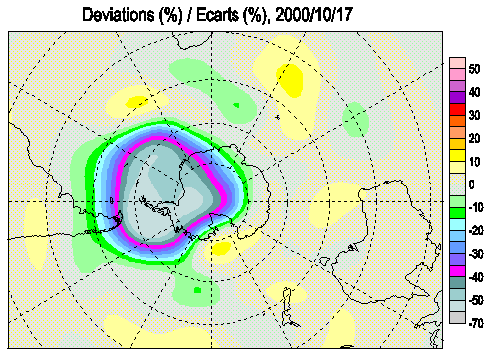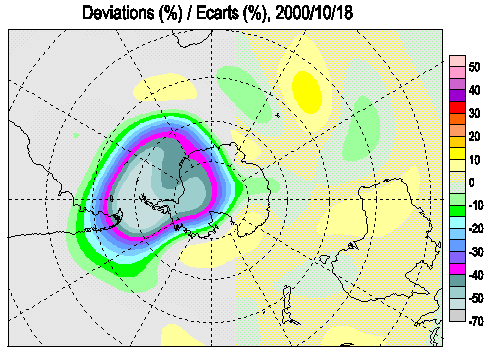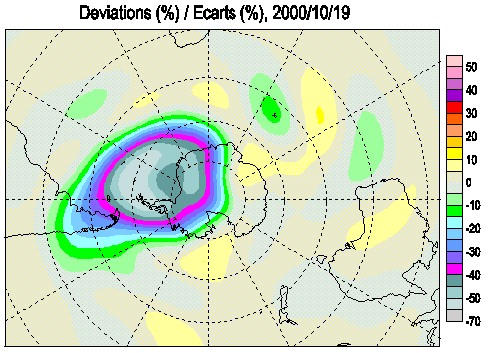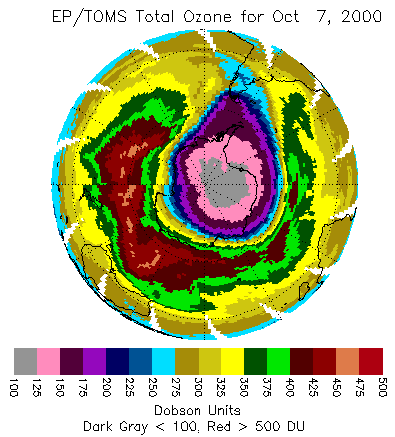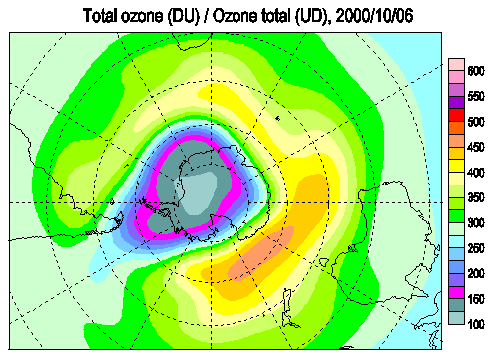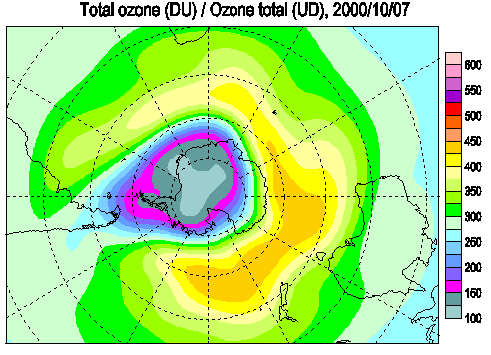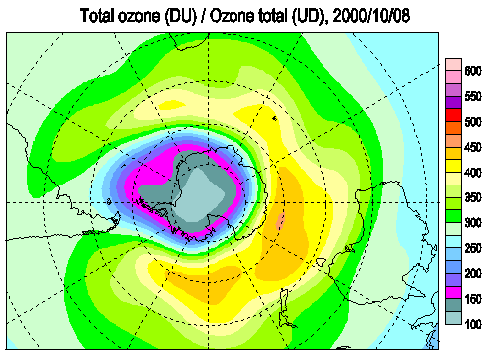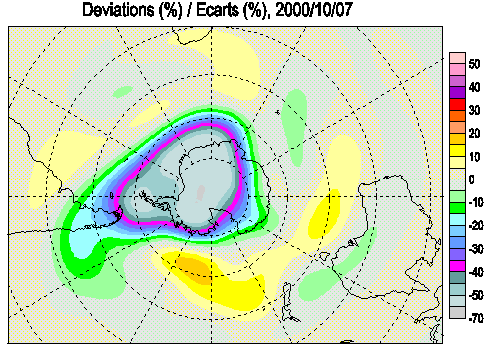|
Ozone Hole Reaches South America October 20,2000-The Ozone hole has been reaching land and population areas in Argentina, Chile and The Falkland Islands all but two days since October 6,2000(October 9 & 10). Ozone levels are down as much as 70% in some areas. The protective level of ozone has dropped below 150 dobson units in some areas. It has reached further north reaching the towns of Rio Gallegos, Puerto Santa Cruz, and Rio Grande affecting an additional 200,000 people.
Central Intelligence Agency Maps from University of Texas Map Center
October 17,2000-The Ozone hole has been reaching land and population areas in Argentina, Chile and The Falkland Islands all but two days since October 6,2000(October 9 & 10). Ozone levels are down as much as 45% in some areas. The protective level of ozone has dropped below 200 dobson units in some areas. The area and population affected including the Argentinean city of Ushaia which has a population of 30,000 and Punta Arenas, Chile which has a population of 120,000 are all at risk during this time period. The public should avoid going outside during the peak hours of 11:00 a.m. and 3:00 p.m. to avoid exposure to the UV rays. If people do go outside during these hours they should wear protective sunscreen and if possible a hat or head covering and sunglasses with a uv rating. For the Second time in less than a week Dangerous levels of UV rays bombard Chile and Argentina
October 12,2000-The Ozone hole again reached land and population areas in Argentina, Chile and The Falkland Islands on October 11, 2000. Ozone levels are down as much as 40% in some areas. The protective level of ozone has dropped below 200 dobson units in some areas. The area and population affected including the Argentinean city of Ushaia which has a population of 30,000 and Punta Arenas, Chile which has a population of 120,000 are all at risk during this time period. The area will be under these conditions for the next 24-30 hours. The public should avoid going outside during the peak hours of 11:00 a.m. and 3:00 p.m. to avoid exposure to the UV rays. If people do go outside during these hours they should wear protective sunscreen and if possible a hat or head covering and sunglasses with a uv rating.
Maps of deviations represent total ozone deviations from the 1978-1988 level estimated using TOMS data for all areas except the Antarctic and from the pre-1980 level estimated using Dobson data over the Antarctic.
Ozone Hole reaches South America again- Dangerous levels of UV rays bombard Chile and Argentina Humans, animals and plant life all at risk of exposure
October 7,2000-The Ozone hole has again reached land and population areas in Argentina, Chile and The Falkland Islands. Ozone levels are down as much as 40% in some areas. The protective level of ozone has dropped below under 200 dobson units in some areas. The area and population affected including the Argentinean city of Ushaia which has a population of 30,000 and Punta Arenas, Chile which has a population of 120,000 are all at risk during this time period. The area will be under these conditions for the next 30-40 hours. In Argentina the regional Secretary of Health is planning on implementing a system that will give warnings of ozone levels and ultraviolet levels to the population. The system will be similar to traffic signals. The public should avoid going outside during the peak hours of 11:00 a.m. and 3:00 p.m. to avoid exposure to the UV rays. If people do go outside during these hours they should wear protective sunscreen and if possible a hat or head covering and sunglasses with a uv rating. The ozone layer in the upper atmosphere is the key filter for damaging ultraviolet-B (UV-B) radiation in the Sun's rays. Without it, organisms suffer extensive DNA damage, which in humans results in a greater increase in the risk of skin cancer, eye cataracts and defects in the body's immune system.
1 Dobson Unit (DU) is defined to be 0.01 mm thickness at STP (standard temperature and pressure). Ozone layer thickness is expressed in terms of Dobson units, which measure what its physical thickness would be if compressed in the Earth's atmosphere. In those terms, it's very thin indeed. A normal range is 300 to 500 Dobson units, which translates to an eighth of an inch-basically two stacked pennies. In space, it's best not to envision the ozone layer as a distinct, measurable band. Instead, think of it in terms of parts per million concentrations in the stratosphere (the layer six to 30 miles above the Earth's surface). The unit is named after G.M.B. Dobson, one of the first scientists to investigate atmospheric ozone . He designed the 'Dobson ozone spectrophotometer' - the standard instrument used to measure ozone from the ground. The Dobson spectrometer measures the intensity of solar UV radiation. A single measurement uses two wavelengths of uv, but for normal operation pairs of readings are taken at two different wavelength settings for a total of four wavelengths, two of which are absorbed by ozone and two of which are not.
Maps of deviations represent total ozone deviations from the 1978-1988 level estimated using TOMS data for all areas except the Antarctic and from the pre-1980 level estimated using Dobson data over the Antarctic.
|

